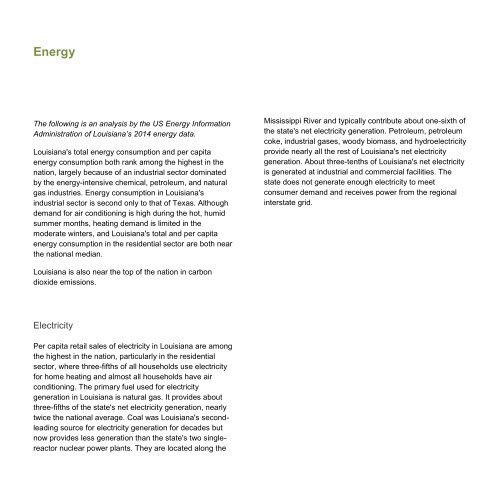USGBC Louisiana 2017 Green Report Online
Over the past ten years, the US Green Building Council Louisiana Chapter and its dedicated network of volunteers have been working to make Louisiana a greener, healthier place to live, work, and learn. Here we offer a snapshot of the progress Louisiana is making towards a more sustainable and resilient future. This report is intended to provide a foundation for further discussions and actions.
Over the past ten years, the US Green Building Council Louisiana Chapter and its dedicated network of volunteers have been working to make Louisiana a greener, healthier place to live, work, and learn. Here we offer a snapshot of the progress Louisiana is making towards a more sustainable and resilient future. This report is intended to provide a foundation for further discussions and actions.
You also want an ePaper? Increase the reach of your titles
YUMPU automatically turns print PDFs into web optimized ePapers that Google loves.
Energy<br />
The following is an analysis by the US Energy Information<br />
Administration of <strong>Louisiana</strong>’s 2014 energy data.<br />
<strong>Louisiana</strong>'s total energy consumption and per capita<br />
energy consumption both rank among the highest in the<br />
nation, largely because of an industrial sector dominated<br />
by the energy-intensive chemical, petroleum, and natural<br />
gas industries. Energy consumption in <strong>Louisiana</strong>'s<br />
industrial sector is second only to that of Texas. Although<br />
demand for air conditioning is high during the hot, humid<br />
summer months, heating demand is limited in the<br />
moderate winters, and <strong>Louisiana</strong>'s total and per capita<br />
energy consumption in the residential sector are both near<br />
the national median.<br />
Mississippi River and typically contribute about one-sixth of<br />
the state's net electricity generation. Petroleum, petroleum<br />
coke, industrial gases, woody biomass, and hydroelectricity<br />
provide nearly all the rest of <strong>Louisiana</strong>'s net electricity<br />
generation. About three-tenths of <strong>Louisiana</strong>'s net electricity<br />
is generated at industrial and commercial facilities. The<br />
state does not generate enough electricity to meet<br />
consumer demand and receives power from the regional<br />
interstate grid.<br />
<strong>Louisiana</strong> is also near the top of the nation in carbon<br />
dioxide emissions.<br />
Electricity<br />
Per capita retail sales of electricity in <strong>Louisiana</strong> are among<br />
the highest in the nation, particularly in the residential<br />
sector, where three-fifths of all households use electricity<br />
for home heating and almost all households have air<br />
conditioning. The primary fuel used for electricity<br />
generation in <strong>Louisiana</strong> is natural gas. It provides about<br />
three-fifths of the state's net electricity generation, nearly<br />
twice the national average. Coal was <strong>Louisiana</strong>'s secondleading<br />
source for electricity generation for decades but<br />
now provides less generation than the state's two singlereactor<br />
nuclear power plants. They are located along the


